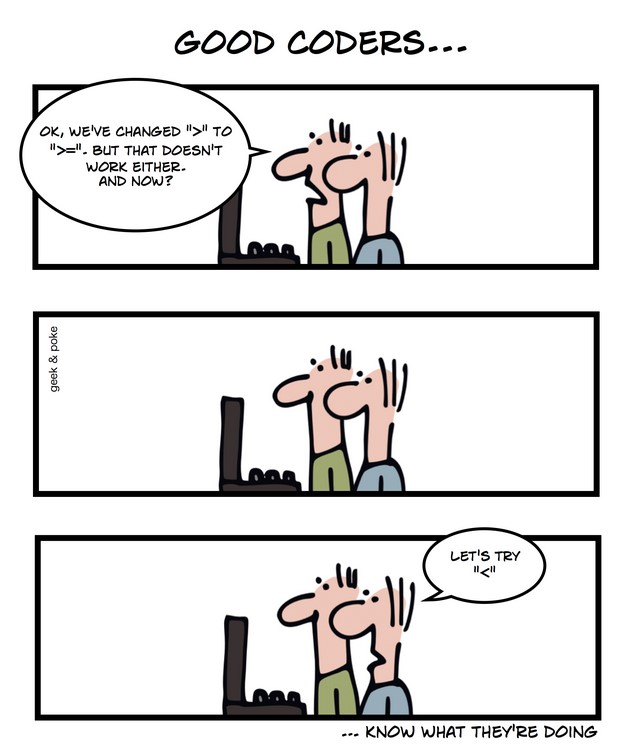by Ger Cloudt, author of “What is Software Quality?”

When browsing the internet I came across above cartoon of “geek & poke”. It reminded me of interviews with job applicants in which I noticed that they do not know what they’re doing. “Good coders know what they’re doing…..”, then why is it so hard to find good coders?
It is one of my biggest disappointments that it seems that many people who claim to be a software engineer do not understand coding anymore. Presenting a basic piece of code with some basic pointer algorithm in C is not understood by job applicants who claim to be knowledgeable and experienced in C-programming. Asking them to solve a simple programming assignment brings many of them to despair……..
Wondering whether I would be the only hiring manager in embedded software stumbling across this problem I started some searching on the internet and encountered “why programmers can’t program” from which I learned I am not the only one encountering this problem. Reading blogs on experiences of recruiting and interviewing SW engineers it seems they have the same problems as I have.
Punch Cards
Having some thoughts about how I learned programming myself in the late 70’s and early 80’s reminds me of the “good old days” in which we did not have an editor. No, when I learned programming we had to use punch cards. You had to type your code using a punching machine producing punch cards. Each line-of-code was captured on one punch card, resulting in a pile of punch cards to be delivered to the computer facility and the day after you could examine your results.
Because you needed to wait for 1 day before the results of your program were available there was quite a threshold in getting these results. Because of this threshold you made sure that you did review your code, together with your colleagues, over and over again to be sure you understood your code such your run would be successful. If not you would have lost at least a complete day.

Press F5
What a contrast to nowadays tooling! In modern IDE’s (Integrated Development Environment) you can type and modify your code and pressing e.g. “F5” will compile-build and execute your program instantly.
In case of any syntax errors you will get feedback in less than seconds and if the build succeeded you can execute your program and tests immediately with fast results. You do not need to wait anymore for any results, results are available instantly. Why worry reviewing your code? Why worry understanding your code? The tooling and test cases will immediately inform you about your success or failure. There is no threshold anymore in the possibility to try changes and see whether they bring the wanted result.
Trying to make it as easy and fast as possible to code and check your results is an invitation to “trial & error” and programmers will start rely on the tooling available.
Automated testing
Next to the modern IDE’s, which help us in coding, we usually automate everything we can automate, enabling a sweet execution of test cases detecting regressions as early as possible. A good practice because when a regression is detected early, it is easier (and cheaper) to correct.
Secondly when changes are made to your code or code is refactored your automated test suite also is used to see whether unwanted side-affects or regressions are introduced.
However the problem, again, is that programmers start to rely on this automated test execution, even if you do not completely understand your code and the tests are passed successfully your program is considered to be ok.
The problem lies in the fact that your test suite can never reach a coverage of 100%. Running all possible execution paths through your code is impossible and there will be always happy-, alternative- or sad-flows which are not executed during your automated tests.
That’s why it is important not fully to rely on your tooling and automated tests but still understand your code and know what you ae doing!
Whiteboard programming
And then we ask the job applicant to produce a piece of code performing a simple basic task on the white board. No IDE, no build, no test cases. Explaining and discussing the code produced with the white board marker. To be honest….., a great way in learning to understand coding. Once, one job applicant who failed the exercise, thanked us afterwards expressing he never learned as much in one hour then during the interview.
Therefore, to become a “good coder who knows what he/she is doing”, do not use the IDE, build and test cases for proving your solution right but instead review, discuss and understand your code before pressing “F5”.